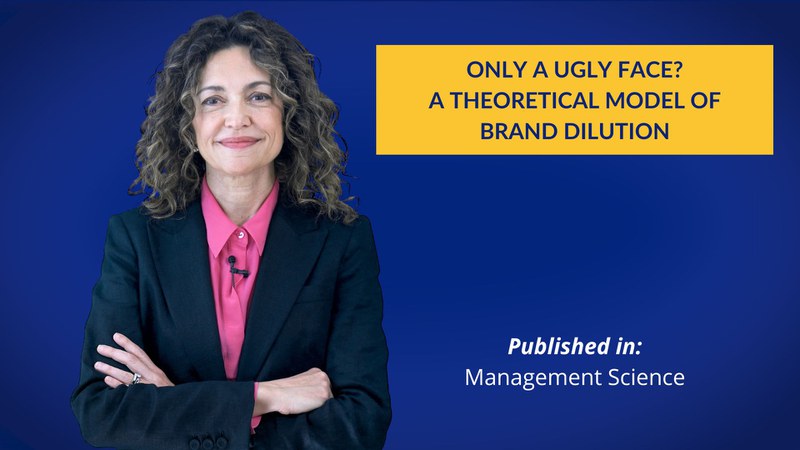Only the ugly face? A theoretical model of brand dilution
Published in: Management Science

Would you opt for a Pierre Cardin suit for a special occasion? Chances are, most wouldn't, and there's a reason behind it. Nowadays, we tend to associate the brand more with inexpensive trinkets like keychains or baseball caps, commonly found in department stores. Contrastingly, about seventy years ago, in the 1950s, Pierre Cardin stood as one of the esteemed names in Parisian haute couture. However, the 1980s saw Pierre Cardin extensively expanding his brand into various unrelated product categories through licensing agreements, often of questionable value. Consequently, consumer perception of the brand shifted negatively. In the scholars’ terminology, the brand name got diluted.
One might be tempted to attribute this dilution to Pierre Cardin's possibly lacking managerial skills despite his brilliance as a fashion designer. Interestingly, in 2004, The Economist noted that "Mr. Cardin, rolling in his royalties, did not seem to care" about the diminishing value of his brand due to these extensions. A similar narrative unfolded across the Atlantic with Halston, whose licensing agreements with JC Penney were criticized for confining his brand to a "golden cage."
So, were Cardin and Halston justified in intentionally diluting their brands?
Traditionally, brand dilution has been viewed as an unintended consequence of poorly executed brand extension strategies, particularly through licensing. David Aaker (1990) described brand dilution as the "ugly face" of brand extension. However, we propose a new perspective on brand dilution and its correlation with licensing. We challenge the notion that brand dilution inevitably stems from missteps in the extension process or that it's more likely to occur under licensing.
Approximately 90% of newly launched products are extensions of existing brand names, offering companies access to new markets and business opportunities. The reputation and image of the parent brand typically empower the extended products, leading to an increase in demand. The characteristics of such extensions, in turn, exert a feedback effect on the parent brand's value, which may be either positive or negative. Scholars and practitioners label the first case brand enhancement and the second brand dilution.
Determining whether an extension is likely to dilute a brand name is a prominent issue in management and marketing practice.
Brand extension can be pursued internally or through licensing. Internal development grants the brand owner full control but may be costly and resource-intensive. Licensing, on the other hand, leverages the skills of the licensee but introduces risks of opportunistic behavior, as the licensee's incentives may not be fully aligned with those of the licensor.
Despite the risks, brand licensing has flourished across various industries, including entertainment, fashion, sports, publishing, music and art, and has been generating substantial revenues.
While brand dilution can occur with both modes, research suggests it's more prevalent with licensing. However, this assertion lacks formal theoretical support. Surprisingly, the decision between internal development and licensing as the mode of brand extension and its implications in terms of brand enhancement/dilution has received little attention in management literature.
Our study fills this gap by developing a micro-economic model that determines the optimal extension mode for a brand owner and the optimal investment to nurture the brand and develop the extension.
Our model brings together three main factors. First, two cross-demand effects, one going from the brand to the extension, and the other one from the extension back to the brand. Second, the benefits from specialization, which imply that extension through licensing is more efficient than through internal development. Third, moral hazard, a situation where the licensee might take risks knowing that the brand owner cannot perfectly monitor its actions.
We find that when both extension methods are equally profitable, the quality of the extension product is higher with licensing, reducing the risk of brand dilution. Brand licensing can be used in fact to counter the reduction in brand value that certain profitable extensions might cause.
Furthermore, the study questions conventional wisdom, commonly held by scholars and practitioners alike, that brand dilution is the unintended consequence of poorly executed strategies. In reality, brand dilution may be a deliberate choice to capitalize on the brand's value, particularly when internal development isn't feasible. We show that there exist licensed extensions that are more profitable than not extending, even if they lead to brand dilution. Companies must recognize this and accept brand dilution as a strategic trade-off to profit from their brands effectively. Brand dilution isn't necessarily a failure in strategy but rather a calculated managerial decision.
Read the full article.
Authors at the Department of Management
Mariachiara Colucci, Associate Professor
Academic disciplines: Management
Teaching areas: Strategic Management
Research fields: Inter-organizational relationships, brand licensing, sustainability and circular economy, new cultural intermediaries, individual creativity.
Mariachiara Colucci is an Associate Professor of Management at the University of Bologna, where she teaches Strategic Management. She also serves as the Director of the MBA program at Bologna Business School. She has been a visiting scholar at the University of Pennsylvania and the Grenoble Ecole de Management. Her research interests include interfirm relationships, in particular brand licensing, as well as creativity, new cultural intermediaries and sustainability, with a specific focus on the fashion industry. Her works have been published in major research outlets such as Management Science, the International Journal of Research in Marketing, Enterprise & Society, and the Oxford Handbook of the Creative Industries.
